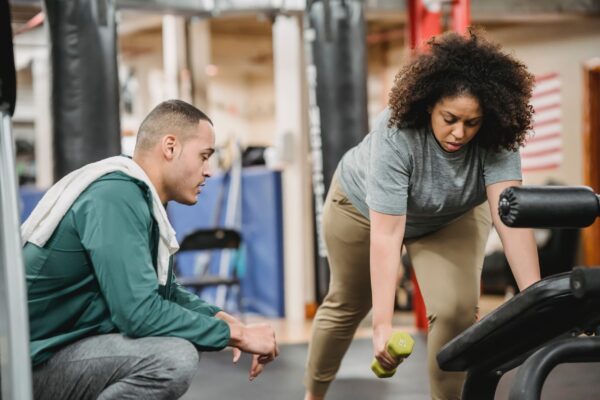
Are you looking for exercises that can help you lose the extra weight? When it comes to physical activity, being overweight can present many difficulties, but with the appropriate workouts, you can begin your fitness journey and reach your weight loss objectives. We’ll examine the top 10 effective exercises designed especially for those who are overweight in this detailed guide. These exercises will support you in beginning your journey to a better lifestyle, regardless of your level of experience.
Introduction
We understand every challenge that people who are overweight and trying to live a healthier lifestyle experience. We think it’s essential to include regular exercise in your routine if you want to lose weight in a healthy way and enhance your overall wellbeing. We’ll give you a thorough rundown of the top exercises created especially for overweight people in this extensive guide. Our goal is to arm you with useful information and actionable advice to support your success in your fitness journey.
Exercise’s Health Benefits for Overweight People
Let’s take a moment to emphasise the many advantages of exercising for overweight people before moving on to the specific exercises:
1 Weight Loss: Consistent exercise helps establish a calorie deficit, which promotes weight loss and fat reduction.
2 Exercise strengthens the heart, decreases blood pressure, and lowers the risk of heart disease. This results in an improvement in cardiovascular health.
3 Strengthened Muscles: Resistance training activities encourage the growth of lean muscle mass, which can speed up metabolism and improve all-around strength.
4 Stretching activities increase joint mobility and flexibility, which lowers the chance of injury.
5 Enhancement of Mood: Exercise encourages endorphin release, which improves mood and lowers stress levels.
The finest workouts for overweight people that can be incorporated into a well-rounded fitness regimen will now be discussed.
1 Walking and Brisk Walking
A low-impact activity that is simple to fit into daily life is walking. It may be done almost anyplace and doesn’t require any special equipment. Start at a comfortable pace, then progressively pick up the pace and distance as you go. The exercise may be made even more intense and can help you burn more calories if you brisk walk. On most days of the week, try to walk briskly for at least 30 minutes.
2 Swimming and Water Aerobics
Due to its low-impact nature, swimming is a very effective workout for overweight people. Water is the best exercise for people with joint pain or limited mobility since its buoyancy relieves stress on the joints. The resistance offered by the water, whether you’re swimming laps or doing water aerobics classes, helps tone muscles and enhance cardiovascular health.
3 Cycling
Cycling is a great kind of exercise that can be customised to fit people of different fitness levels. Cycling provides a fantastic cardiovascular workout while being easy on the joints, whether you enjoy riding outside or inside. As your fitness increases, start with shorter rides and gradually lengthen and intensify them.
4 Strength Training with Resistance Bands
Strength training activities must be a part of your programme if you want to increase muscle growth and metabolism. Resistance bands are a convenient and economical equipment that can be used to carry out a variety of exercises that target various muscle groups. Work several muscle groups by include exercises like bicep curls, squats, and shoulder presses to improve overall strength.
5 Yoga and Pilates
Pilates and yoga are both excellent choices for obese people who want to increase their flexibility, posture, and core strength. These exercises are appropriate for all levels of fitness since they emphasise controlled movements and correct alignment. Joining a class or watching online tutorial videos can offer direction and guarantee appropriate form.
6 High-Intensity Interval Training (HIIT)
Short bursts of intense activity are interspersed with fast rest intervals to create HIIT exercises. These exercises burn a lot of calories quickly while also enhancing cardiovascular fitness. Adapt the exercises’ time and intensity to your current level of fitness, progressively raising the level of difficulty as you go.
7 Low-Impact Aerobics
Low-impact aerobics programmes or workouts are meant to put as little strain as possible on the joints while yet working the heart. These exercises frequently involve low-impact dancing routines, side steps, and marching. Low-impact aerobic exercise can help you lose weight and increase cardiovascular fitness without putting too much stress on your joints.
8 Stair Climbing
You may effectively activate your lower body muscles and increase your heart rate by including stairs in your exercise regimen. Whether you opt to utilise a stair climber machine or climb actual stairs, this exercise enhances leg strength and cardiovascular health. Set a moderate pace at first, then gradually lengthen and intensify your stair climbing sessions.
9 Group Fitness Classes
Taking part in group exercise sessions can help you along your fitness path by offering encouragement, support, and a sense of community. Numerous fitness facilities provide classes specifically designed for obese people, emphasising activities appropriate for all fitness levels. Find a class that fits your interests and goals, whether it be Zumba, aerobics, or strength training.
10 Proper Warm-up and Cool-down
Whatever exercises you select, it is imperative to give thorough warm-up and cool-down routines first priority. Spend a few minutes performing dynamic stretches and motions to warm up your muscles before beginning your workout. Afterward, cool down with static stretches to encourage flexibility and reduce muscular soreness.
Conclusion
Regular exercise is an essential part of living a healthy lifestyle, especially for overweight people who want to get fitter and feel better overall. The workouts described in this thorough manual provide a number of options to accommodate various preferences and fitness levels. As your fitness level increases, remember to progressively increase the intensity and duration of your workouts.
Remember that consistency, appropriate form, and listening to your body are crucial as you start your fitness journey. Before beginning any new exercise programme, it is advised that you speak with a healthcare provider or a qualified fitness instructor, especially if you have any pre-existing medical concerns.
You can significantly advance towards your weight reduction and fitness goals by embracing a mix of cardiovascular exercises, strength training, flexibility workouts, and adding adequate warm-up and cool-down routines. Stay committed, have patience, and enjoy each victory as it comes.
FAQs:
Q1. Can I begin working out if I am quite overweight?
A1. Absolutely! Before beginning any workout programme, it’s crucial to speak with your doctor, especially if you have underlying medical issues. They can advise you and suggest exercises that are fit for your individual requirements.
Q2. How frequently should I work out to get results?
A2. Aim for 75 minutes of severe aerobic exercise or 150 minutes of moderate aerobic exercise each week for best outcomes. Spread out your workouts over the course of the week to promote consistency and recovery.
Q3. Are these workouts appropriate for beginners?
A3. Yes, novices can use these exercises. As your fitness level increases, progressively up the duration and intensity of your workouts. Observe your body’s needs and take rest days as necessary.
Q4. What attire is appropriate for working out?
A4. Dress in loose-fitting, breathable garments to promote mobility. Spend money on supportive shoes that offer stability and cushioning to safeguard your joints.
